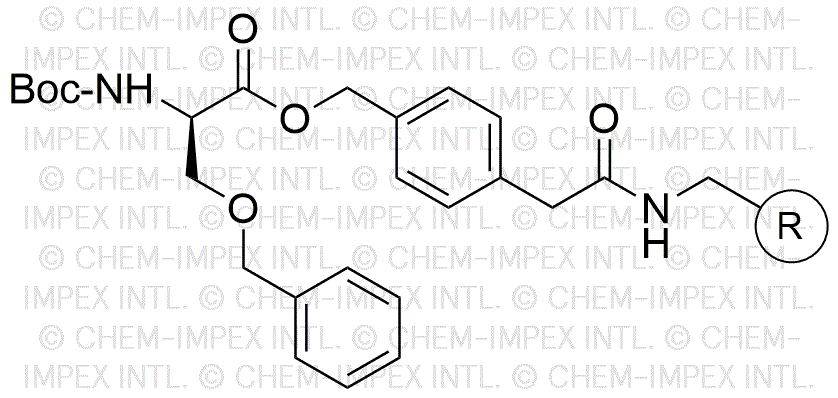Boc-O-benzyl-D-serine 4-oxymethylphenylacetamidomethyl is widely utilized in research focused on:
- Peptide Synthesis: This compound serves as a valuable building block in the synthesis of peptides, enabling researchers to create complex structures for drug development.
- Drug Design: Its unique functional groups allow for modifications that can enhance the bioactivity of pharmaceutical compounds, making it essential in medicinal chemistry.
- Bioconjugation: The compound can be used to attach biomolecules to surfaces or other molecules, which is crucial in developing targeted therapies and diagnostics.
- Research in Neuroscience: It plays a role in studying neurotransmitter systems, helping researchers understand neurological diseases and potential treatments.
- Material Science: The compound can be incorporated into polymers to create materials with specific properties, useful in various industrial applications.
Información general
Propiedades
Seguridad y normativas
Aplicaciones
Boc-O-benzyl-D-serine 4-oxymethylphenylacetamidomethyl is widely utilized in research focused on:
- Peptide Synthesis: This compound serves as a valuable building block in the synthesis of peptides, enabling researchers to create complex structures for drug development.
- Drug Design: Its unique functional groups allow for modifications that can enhance the bioactivity of pharmaceutical compounds, making it essential in medicinal chemistry.
- Bioconjugation: The compound can be used to attach biomolecules to surfaces or other molecules, which is crucial in developing targeted therapies and diagnostics.
- Research in Neuroscience: It plays a role in studying neurotransmitter systems, helping researchers understand neurological diseases and potential treatments.
- Material Science: The compound can be incorporated into polymers to create materials with specific properties, useful in various industrial applications.
Documentos
Hojas de datos de seguridad (HDS)
La SDS proporciona información de seguridad completa sobre la manipulación, el almacenamiento y la eliminación del producto.
Especificación del producto (PS)
La PS proporciona un desglose completo de las propiedades del producto, incluida la composición química, el estado físico, la pureza y los requisitos de almacenamiento. También detalla los rangos de calidad aceptables y las aplicaciones previstas del producto.
Certificados de análisis (COA)
Busque certificados de análisis (COA) ingresando el número de lote del producto. Los números de lote y de partida se pueden encontrar en la etiqueta de un producto después de las palabras "Lote" o "Lote".
Número de catálogo
Número de lote/lote
Certificados de origen (COO)
Este certificado de origen confirma el país en el que se fabricó el producto y también detalla los materiales y componentes utilizados en él y si se deriva de fuentes naturales, sintéticas u otras fuentes específicas. Este certificado puede ser necesario para cumplir con las normativas aduaneras, comerciales y regulatorias.
Número de catálogo
Número de lote/lote
Hojas de datos de seguridad (HDS)
La SDS proporciona información de seguridad completa sobre la manipulación, el almacenamiento y la eliminación del producto.
DownloadEspecificación del producto (PS)
La PS proporciona un desglose completo de las propiedades del producto, incluida la composición química, el estado físico, la pureza y los requisitos de almacenamiento. También detalla los rangos de calidad aceptables y las aplicaciones previstas del producto.
DownloadCertificados de análisis (COA)
Busque certificados de análisis (COA) ingresando el número de lote del producto. Los números de lote y de partida se pueden encontrar en la etiqueta de un producto después de las palabras "Lote" o "Lote".
Número de catálogo
Número de lote/lote
Certificados de origen (COO)
Este certificado de origen confirma el país en el que se fabricó el producto y también detalla los materiales y componentes utilizados en él y si se deriva de fuentes naturales, sintéticas u otras fuentes específicas. Este certificado puede ser necesario para cumplir con las normativas aduaneras, comerciales y regulatorias.


